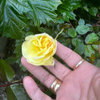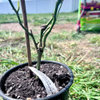Chilli Thrips (Scirtothrips dorsalis) defeated by oils and soaps
greentiger87
10 years ago
Featured Answer
Sort by:Oldest
Comments (14)
michaelg
10 years agogreentiger87
10 years agoRelated Discussions
Insecticides For Thrips
Comments (20)Hi Jorge, Below is the link to another discussion elsewhere on the Rose Forum that cites GREAT information from the Univ of FLA. If you download the PowerPoint about "Ecology and Management of Scirtothrips dorsalis," check out slide 26. It details exactly what chemical control options are available... Me personally, I'm sticking with Neem Oil. The active ingredient--Azadirachtin-- disrupts the molting cycle; so it's a potent weapon that non-toxic too. Neem oil is great for a host of things, but be sure that you are getting the full strength Neem oil--with the Azadirachtin listed as active ingredient, not the Clarified Hydrophobic Extract of Neem Oil (not half as potent.) And, like any other horticultural oil used to spray with--be careful about time of day. You also need to mix it as such: 2 Tblsp of Neem + 2 tsp of liquid soap for emulsifier per gallon of spray mix. The Chilis have made their way to St. Pete, so I feel for ya, Brother! Here is a link that might be useful: Chili Thrip info...See MorePredator for thrips in no-spray rose garden ??
Comments (9)Thanks Silvia, it's an interesting site, never seen it before, and I'm keeping it for future reference... have you ever used the mail-order bugs ? and how did it work out for you, did they just fly away ?... has anyone here ever used the Hot Pepper Wax Spray ? apparently it is cayenne peppers in a parrafin-wax base, and the wax holds the hot-pepper on the plant, it is supposed to be good on food-crops also, organic.... I know in my garden the bugs avoid the hot-peppers, they don't like them... also Tom pointed that out when he was here... it stands to reason the spray might work on most everything... also it won't fly away like the predator-bugs do..... sure wish I could get some feed-back on this... I went on Google and there are many mail-order places that carry it, but it is kind of pricey what with the shipping etc. Bonide lists 2 places here in St Pete that carry their products, I called them and they don't have the Hot Pepper spray, but Willow Tree said they would ask their Salesman when he comes, and call me back.... but I'd like to hear from others who have actually used the stuff.... Thanks folks, sally...See MoreWhy do my pepper leaves look like this??
Comments (41)I gave up growing bells when HEB started selling those big red ones for 98 cents. Then a couple weeks ago they had them 2 for $1 and I went hog wild! Some got frozen, the rest I hickory smoke-dried and turned into chili powder, Those will be blended in with whatever hot pepper powder I end up with at season's end. Man what a great year this is turning out to be. :)...See MoreChilli Thrips in California!
Comments (31)I am so sorry to hear that chilli thrips are in California. As some of you may remember I discovered them in my garden in October of 2012 and wrote about it on the Texas Garden Web here. There are pictures of what the damage looks like on roses and if you scroll down about 2/3 there are pictures of other plants with chilli thrips damage. There are also several links to more information. Some still work and some do not. The Houston Rose Society link still works and has several pages of information and photos. Chilli thrips can be ID'd with a 10 power jeweler's loupe. I described how in these two paragraphs. "I took several sheets of white paper, made a slight funnel with them, held them under a leaf and tapped it. Along with some teeny dust size black dots of what I think was frass I saw one tiny yellow dot moving. It was less than the size of period at the end of this sentence. I focused on it using a 10X jewelers loupe and the tiny insect, 1/10 the size of a flower thrips came into view. It was unmistakable a chilli thrips, had the little lines on it and everything. And then it flew away in front my of very eyes (to use an old expression). I then took the paper to an opened rose that had the brown streaks, tapped it, out dropped two little spiders which quickly ran off the paper. Were they eating the chilli thrips? I don't know. But remaining on the paper were four tiny yellow dots that were moving. Putting the loop on them I could see they were the immature forms of chilli thrips; no wings." I also ID'd them on several other type of plants using that method. I knew a young gardener who was willing to treat the roses with insecticides. I was NOT willing. So he came and dug up about 50 mature roses and I redesigned the whole garden. I had enjoyed roses for about 30 years and I was ready for something else requiring less care so it was no big deal. As fate would have it, we've had some colder winters and I haven't seen evidence of chilli thrips damage on the other plants since, and there were quite a few. Since I don't spray maybe a chilli thrips predator showed up? Who knows why they went away -- in my garden anyway. I haven't kept up with what's going on with the San Antonio Rose Society member gardens, but about half their members were already spraying for them when I discovered the damage on my roses. I wish you all the best. These things have a way of working themselves out and are often not as bad as we thought they would be. That was the case for my garden....See MoreBrittie - La Porte, TX 9a
10 years agobart_2010
10 years agomichaelg
10 years agoeahamel
10 years agolola-lemon
10 years agojoshtx
10 years agoamberroses
10 years agoBrittie - La Porte, TX 9a
10 years agomichaelg
10 years agosaldut
10 years agobart_2010
10 years ago








greentiger87Original Author